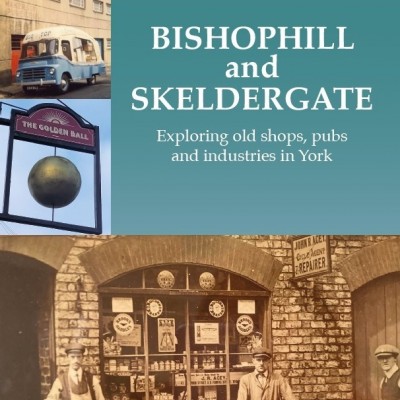



View navigation
Census data: 1891, 1901, 1911 (accessible via Ancestry.com at Explore York at no charge)
Maps
Newspapers, esp. York Herald and Yorkshire Evening Press
Photographs: see Explore York Libraries & Archives http://www.exploreyork.org.uk
Aerial: http://www.britainfromabove.org.uk
War memorials: St Clements Church (156 names of dead); St Clements School plaque in St Clements Church (73 names of dead); and Scarcroft School plaque (66 names of dead). Southlands Methodist Church Roll of Honour has ten names.
A list of around 153 names of South Bank/Clementhorpe/Nunnery Lane military dead, has been extracted from Explore York Libraries & Archives. This (with addresses of next of kin) has been augmented with regiment, rank, age and location of UK memorials. Follow this link for more details of our database of soldiers killed in the war.
Penny Bleddyn, War Memorials and Public Commemoration in York 1914-25 (University of York, Borthwick Papers No.122, 2013)
Adrian Gregory, British Society and the First World War (Cambridge, 2008) shelved at 941.083 HIS at Explore York.
A.J. Peacock, York in the Great War 1914-1918 (1993) – shelved at 942.843 (Y) HIS
at Explore York.
David Rubinstein, York in War and Peace 1914-1945 (Quack Books, 2014)
Alan Simmonds, Britain and World War 1 (Routledge, 2011) shelved at 940.341 HIS at Explore York.
Kate Tiller, Remembrance and Community: War Memorials and Local History, (BALH, 2013).
Van Wilson, These Were Earth’s Best: Voices of the First World War (York Oral History Society, 2014).
Websites
http://www.iwm.org.uk/history-terms/first-world-war : an interesting selection of themes and images including the impact of aerial bombing on Britain. Our locality experienced this in May 1916, with casualties.
The National Archives: https://www.nationalarchives.gov.uk/first-world-war/
British Library: http://www.bl.uk/world-war-one
Supported by over 500 historical sources from across Europe, this resource examines key themes in the history of World War One. Explore a wealth of original source material, over 50 newly-commissioned articles written by historians, teachers’ notes and more to discover how war affected people on different sides of the conflict.
http://www.york.ac.uk/ipup/
Experiencing the Great War in York in World War 1: a project of the University of York Institute for Public Understanding of the Past (IPUP):
1. Resources for ‘York in World War One’
2. Trail leaflet and Audio Guide
http://encyclopedia.1914-1918-online.net/articles/
Newspapers offer chronology, a sense of ‘being there‘, and identify issues and stories. For an example see the daily York Herald, Sat. 6 March 1915. Page seven largely comprises ‘St Clements’s Parish List’: a list of some 447 parishioners serving with the armed forces, with regiment/ship. Alongside are photographs including one of Rev. Canon Argles, rector for over 40 years: ‘When he became rector the population of the parish was about 4,000; now it is over 12.000’. There are also photos of St Clements Church, the Rectory and South Bank Mission Church, South Bank Avenue, ‘also used as a Day School’.
On page six, column e, of the same issue of York Herald is an item York and the Great War: The Belgian Club. Officials of York Belgian Club had issued an appeal for funds for its HQ at the Settlement, St Mary’s. There were 700 names (of refugees) on the club’s register. 400 of these were from York and nearby villages. Up to 80 attended the club on Sat/Sun evenings. Weekday attendance was around 20 to 30. This story prompts questions: what was the local response to Belgian refugees? did attitudes change over time? if so, how?
.
http://www.britishnewspaperarchive.co.uk. Digitised newspapers can be accessed via this subscription service. There is no charge for accessing the service at the British Library Boston Spa.
Digitised newspapers:
York Herald 1801-1900
Yorkshire Evening Post 1890-1954
Yorkshire Post and Leeds Intelligencer 1866-1953
York Gazette 1819-1913
York Herald, Yorkshire Evening Press and the Yorkshire Gazette are available on microfilm for 1914-1918 (and subsequent years) at Explore York.
National Railway Museum showcases the role of railways in the war and commemorate the sacrifice of railwaymen. Key will be a list of some 20,000 names of railway employees who died during the First World War
http://www.nrm.org.uk/NRM/RailwayStories/WW1/main.aspx
York Museum Trust: An exhibition – 1914 When the World Changed Forever – at the Castle Museum.
Local history societies: Fishergate, Fulford and Heslington LHS has investigated military hospitals in York, and is exploring lives of those on war memorials, sharing results on its website http://ffhyork.weebly.com
Sources for exploring the war are publicised by other societies. For example, an article on using school alumni magazines was published by the Yorkshire Architectural and York Archaeological Society ( D. Hunter and J. Bibby, ‘Elmfield College and World War One’ in Y.A.Y.A.S. Times, no. 58, February, 2013).
Belgian nuns and refugee children were given a home in the Bar Convent; and its concert hall was converted into a hospital ward for wounded soldiers.
Nunthorpe Hall was one of seven York auxiliary military hospitals. It opened in October 1915 with 50 beds, was bombed in 1916, closed in 1919 having treated 914 patients and subsequently opened as Nunthorpe Grammar School in 1920.
The Mount was also prepared as a hospital in August 1914. Local Friends then negotiated to have the Clifford St Meeting House used as a hospital instead, so that the girls could return to school in September. A school history refers to the community during the war years. Most of the girls were then Quaker or Methodist. Some had male relatives at The Front, others had relatives suffering for their conscientious objection.
Potential School – Clements Hall links:
Share research: invite schools to display work.
Share primary sources, and ideas re linking them. eg link names of war dead with obits in occupational records such as North East Railway magazines (on shelves of NRM library); and Rowntree staff magazines (at Borthwick IHR). Names and addresses of many who died as a result of the war have been passed to Millthorpe and The Mount Schools for their use.
Explore collaboration eg walking trails (Clements Hall LHG has data including photos of local shops in 1913).